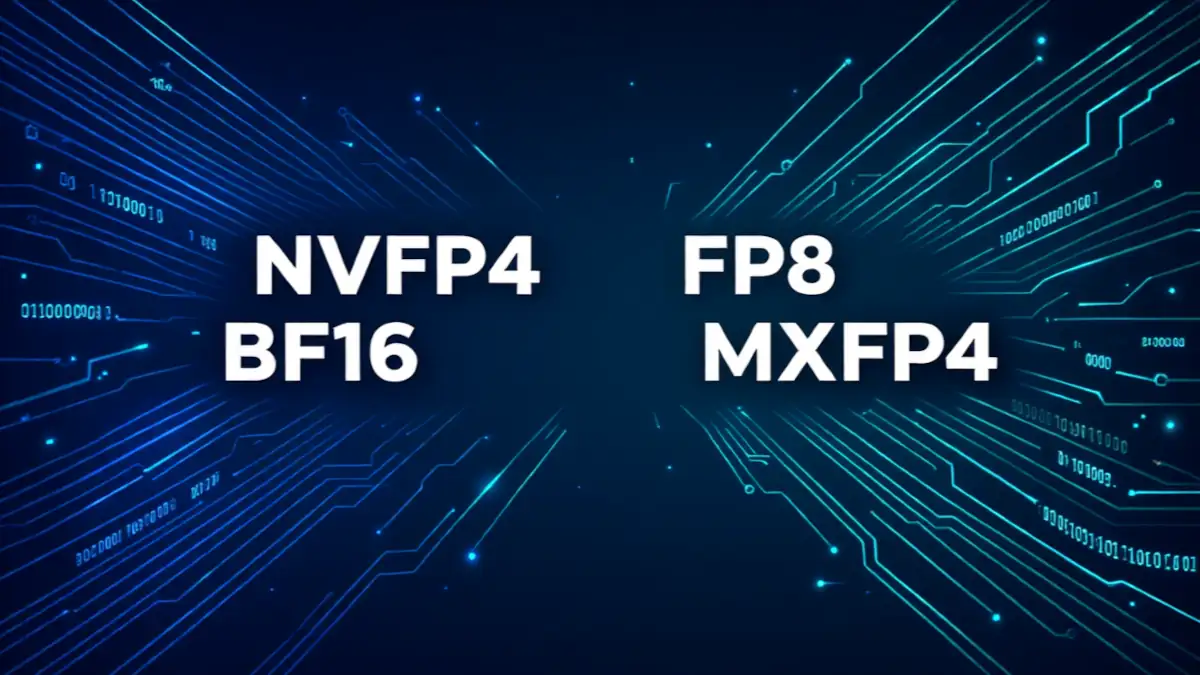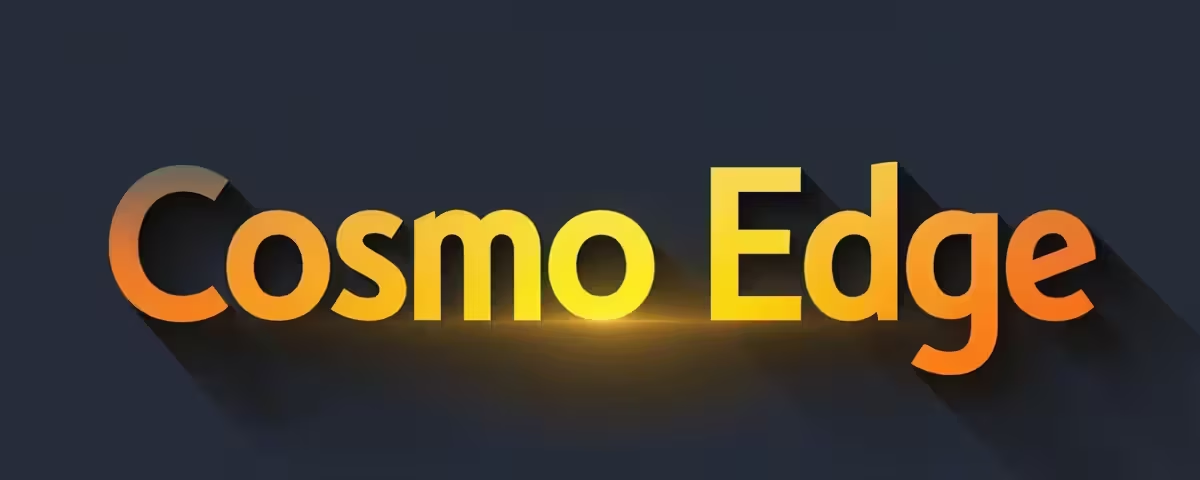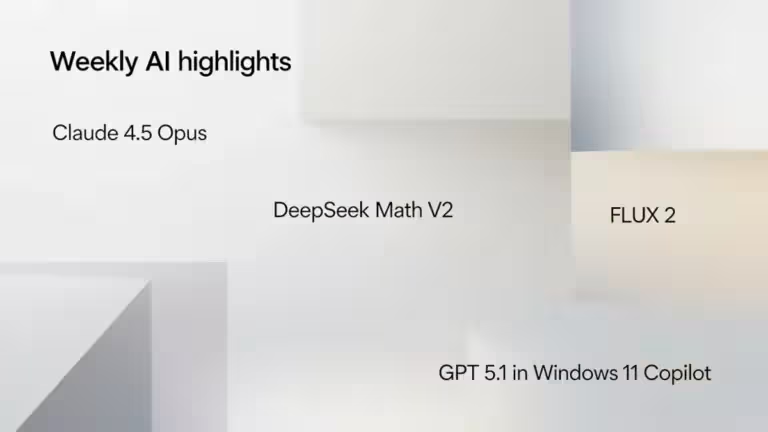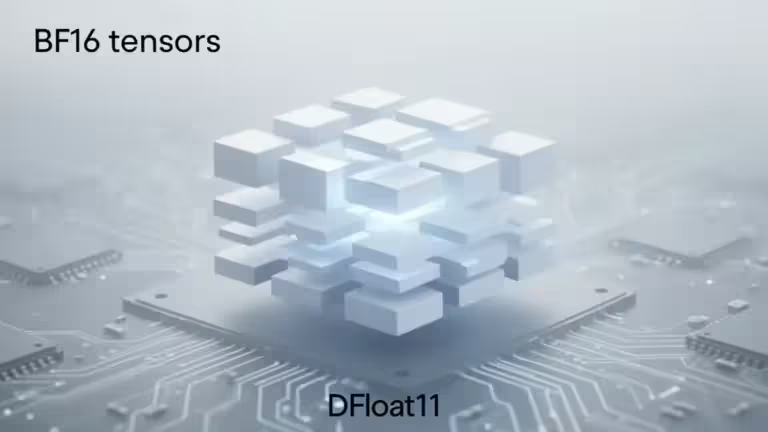NVFP4 vs FP8 vs BF16 vs MXFP4: comparison of low-precision formats for AI

The world of artificial intelligence is not limited to the headline-grabbing giants like ChatGPT, Gemini or Claude. Behind these flagship models, countless AI projects must deal with far more practical constraints: the cost of training and the speed of inference. Both factors largely depend on the numeric format chosen to represent weights and calculations. As models scale up, the precision of numbers becomes a decisive lever, directly influencing execution speed, energy consumption, and result fidelity.
Today, four formats stand at the forefront: BF16, FP8, NVFP4 and MXFP4. But which one is best suited for training a large language model (LLM)? Which should you choose for inference in the cloud or on GPU? This comparison breaks it down. For a broader and more detailed look at the NVFP4 format, see our dedicated page.
Why is numerical precision critical in AI?
In AI training, every mathematical operation is repeated billions of times. Using more compact formats allows you to:
- train models faster,
- reduce GPU memory usage,
- lower energy consumption.
But caution is required: compressing numbers too much can introduce errors, instability, or precision loss in certain tasks like logical reasoning, code execution, or math-heavy workloads.
Quick overview of the formats
- BF16 (Bfloat16): the veteran. A 16-bit format, very stable but resource-hungry.
- FP8 (Floating Point 8-bit): the balance between speed and precision, widely adopted since 2022.
- NVFP4 (NVIDIA FP4): the newcomer, a 4-bit format optimized for Blackwell GPUs.
- MXFP4 (Microscaling FP4): an alternative 4-bit format explored in academic research, but less stable at scale.
Comparison table of low-precision formats
| Format | Precision (benchmarks) | Speed (vs BF16) | Memory (vs FP8) | Recommended use case |
|---|---|---|---|---|
| NVFP4 | ~98–99% of FP8, equivalent on most tasks, slight drop on code (arXiv) | 4× to 6× faster (Tom’s Hardware) | -50% (NVIDIA blog) | Large-scale LLM training and inference on Blackwell GPUs |
| FP8 | ~99–100% of BF16, very reliable | 2× to 3× faster | -50% vs BF16 | Current standard for LLM training |
| BF16 | Reference, maximum precision | Baseline (1×) | 2× memory vs FP8 | Critical fine-tuning, precision-sensitive tasks |
| MXFP4 | Less stable than NVFP4 at scale (Yang et al.) | Similar gains to NVFP4 but uncertain convergence | -50% vs FP8 | Experimental research, some inference workloads |
BF16: the safe but heavy choice
BF16 (Bfloat16) has long been the workhorse of data centers. Its high precision makes it a safe option: low risk of instability and results close to full precision.
The downside: it is resource-intensive. Compared to FP8, BF16 requires about twice as much memory and two to three times more compute. To verify: in critical fine-tuning tasks such as healthcare or finance, BF16 remains essential, though increasingly a luxury.
FP8: the balance everyone adopted
FP8 quickly overtook BF16 as the standard for LLM training. With accuracy close to BF16 and half the memory consumption, it is now widely used in AI services. Companies rarely disclose FP8 adoption, making real deployment hard to measure.
According to NVIDIA, FP8 was the first low-precision format validated at scale in production, proving that costs could be cut without sacrificing quality.
NVFP4: NVIDIA’s 4-bit revolution
With NVFP4, NVIDIA pushes precision efficiency even further. The format uses a clever design:
- FP8 scaling on each block of 16 values,
- a global FP32 factor to stabilize the whole.
The result: performance very close to FP8, but with half the memory and up to 6× the speed of BF16.
An academic study on arXiv confirmed that on massive training (12B parameters, 10T tokens), the quality gap with FP8 was minimal: only 1 to 1.5% difference on validation.
It is like going from a hybrid car (FP8) to a high-performance electric car (NVFP4): lighter, faster, and arriving almost at the same result.
MXFP4: the academic alternative
MXFP4 is a 4-bit format explored by academic research. Based on microscaling techniques, it aimed to offer a more open path, less dependent on NVIDIA.
However, recent studies (Yang et al.) show that its stability is inferior to NVFP4 when scaling up to massive training runs. Models converge less reliably, with higher error risks.
The question of independent benchmarks using NVFP4, and its direct comparison with MXFP4, on open-weight models beyond Nemotron and DeepSeek-R1 now has documented answers.
One example is an academic study on Llama-3.1-8B-Instruct, which evaluated NVFP4 and MXFP4 under different quantization schemes. Results showed NVFP4 maintained higher accuracy and lower mean squared error than MXFP4, especially with optimized GPTQ variants. In weight-only quantization, NVFP4 lost only about 2% accuracy versus full precision, while MXFP4 degraded more significantly (Arxiv, 2025).
Beyond this, the open-weight GPT-OSS models developed jointly by NVIDIA and OpenAI validate NVFP4’s strength. Available in 120B and 20B versions, these models leverage NVFP4 for faster and more energy-efficient inference without notable accuracy loss. They provide a real-world independent benchmark on large open models beyond Nemotron and DeepSeek-R1 (HotHardware, 2025; Coinfomania, 2025).
Further, technical analyses explain why NVFP4 outperforms MXFP4: its micro-block scaling of 16 values enables finer quantization, reducing errors on large tensors. Publications like Edge AI Vision highlight that this design improves inference robustness across a wide range of open-weight models (Edge AI Vision, 2025). Benchmarks such as MLPerf also showcase the massive adoption of NVFP4 in the Blackwell ecosystem, proving its reach well beyond Nemotron and DeepSeek-R1 (NVIDIA Developer, 2025).
In summary, independent benchmarks comparing NVFP4 and MXFP4 on diverse open-weight models do exist. Results converge on the same point: NVFP4 offers superior accuracy and efficiency, validated by both academic studies and industrial deployments on widely available open models.
Which formats for which use cases?
- Massive LLM training: NVFP4 on Blackwell GPUs is unmatched in speed and cost efficiency.
- Cloud production: FP8 remains a safe and widely supported standard.
- Precision-sensitive fine-tuning: BF16 is still the safest choice, though less efficient.
- Experimental research: MXFP4 may interest labs testing new quantization schemes.
Conclusion: toward a 4-bit future?
The race between BF16, FP8, NVFP4 and MXFP4 illustrates a clear trend: the industry always pushes for fewer bits and more performance.
NVFP4 stands as the most serious candidate to succeed FP8, at least on Blackwell GPUs. But as always in technology, the outcome depends on more than benchmarks. Adoption will rely on cloud providers, open source frameworks, and the confidence of researchers and developers.
NVFP4 article series
- NVFP4: understanding NVIDIA’s new 4-bit format for AI
- NVFP4 vs FP8 vs BF16 vs MXFP4: comparison of low-precision formats for AI ← You are here
- NVFP4 stability and performance: what academic studies and benchmarks reveal
- Why NVFP4 matters for business: costs, speed, and adoption in AI
Your comments enrich our articles, so don’t hesitate to share your thoughts! Sharing on social media helps us a lot. Thank you for your support!






